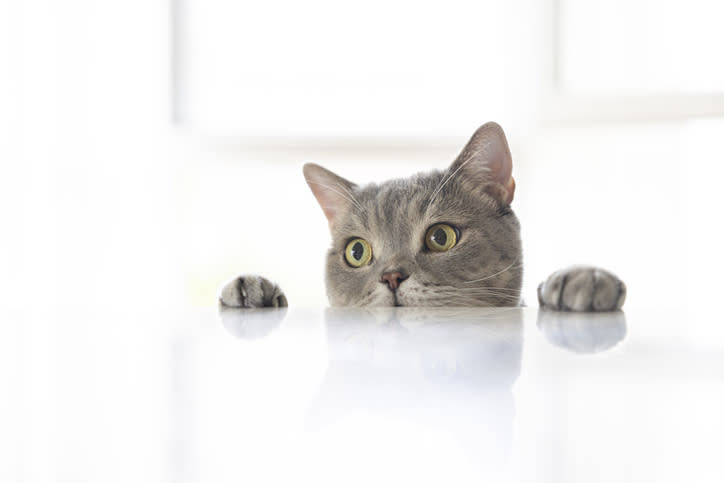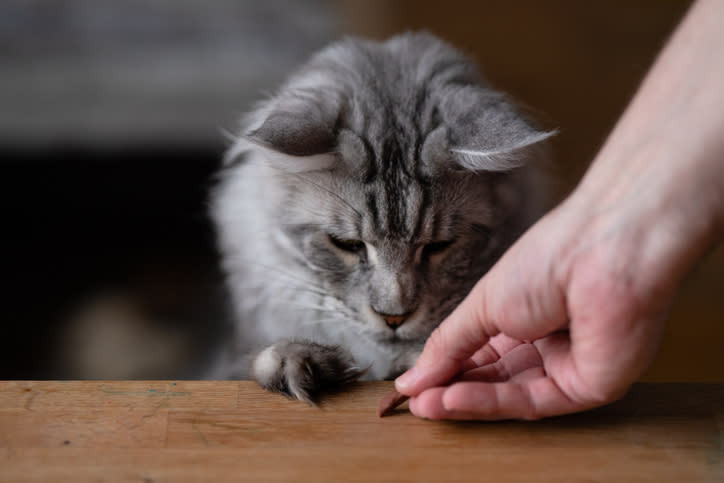The smell of sizzling bacon in the morning is undeniably tempting, and those pleading eyes of your feline friend might make you consider sharing a piece. As devoted cat owners, it’s natural to wonder if our beloved pets can indulge in the same breakfast treats we enjoy. But when it comes to bacon, is it a safe and savory morsel for cats, or a potential health hazard?
While cats are carnivores and the aroma of bacon might seem irresistible to them, regularly offering bacon to your cat is not advisable. Let’s delve into why bacon is generally not a good choice for your feline companion, and explore safer, healthier alternatives to keep your kitty happy and well-fed. We’ll consult veterinary experts to understand the real risks associated with feeding bacon to cats.
The Allure of Bacon to Cats: Why Do They Beg?
Cats are obligate carnivores, meaning their diet primarily consists of meat. The strong, meaty scent of bacon naturally attracts them. The high-fat content and salty flavor also make it palatable to many cats, triggering their instinctual desire for rich, energy-dense foods. This natural inclination, combined with their innate begging behavior, can lead to cats persistently seeking bacon whenever they smell it cooking or see you eating it. However, just because they are drawn to it doesn’t mean it’s good for them.
Why Bacon is Bad for Cats: Unpacking the Dangers
While a tiny nibble of bacon might not cause immediate harm, making it a regular part of your cat’s diet, or even offering it frequently as a treat, can lead to several health issues. Veterinarians emphasize the following key concerns:
High Fat Content
“Technically speaking, kitty can have some bacon, but with an important caveat: It’s high-fat and fairly nutrient-poor, so it’s best avoided or given in extremely small quantities,” advises Dr. Rebecca Greenstein, veterinary medical advisor for Rover. Bacon is extremely high in fat. Consuming fatty foods, especially in large quantities or regularly, can lead to gastrointestinal upset in cats, including vomiting and diarrhea. More seriously, it can contribute to pancreatitis, a painful inflammation of the pancreas. Pancreatitis can range from mild to severe and require veterinary intervention.
Excessive Salt
Dr. Jennifer Power, senior veterinarian for Small Door Vet, highlights another critical concern: “Bacon is high in salt and fat, which can be harmful to cats and lead to digestive issues or even pancreatitis in severe cases.” The high sodium content in bacon is detrimental to feline health. Excessive salt intake can cause dehydration and, in severe cases, sodium ion poisoning. Symptoms of salt poisoning in cats can include vomiting, diarrhea, tremors, seizures, and even coma. Cats are much smaller than humans, and their kidneys are not designed to process high levels of sodium.
Harmful Preservatives and Seasonings
Bacon often contains preservatives like nitrates and nitrites, which, while used to cure and preserve the meat, are not beneficial for cats. Additionally, bacon is frequently seasoned with salt, pepper, and sometimes garlic or onion powder. Garlic and onions, even in powder form, are toxic to cats and can cause damage to their red blood cells, leading to anemia.
Lack of Nutritional Value
While bacon is derived from meat, it offers minimal nutritional value for cats. Cats require a balanced diet rich in protein, essential amino acids, vitamins, and minerals, which are formulated in high-quality commercial cat foods. Bacon is primarily composed of fat and sodium, lacking the essential nutrients cats need to thrive. It’s essentially empty calories for your feline companion.
What Happens If Your Cat Eats Bacon? Recognizing the Signs
If your cat manages to sneak a piece of bacon, it’s important to monitor them for any adverse reactions. Symptoms of digestive upset or more serious issues can vary, but watch out for:
- Vomiting: This is a common reaction to consuming fatty or rich foods like bacon.
- Diarrhea: Loose stools can also indicate digestive distress.
- Lethargy or Weakness: If your cat seems unusually tired or weak, it could be a sign of illness.
- Loss of Appetite: Refusal to eat their regular food after consuming bacon could be concerning.
- Increased Thirst and Urination: Excessive salt intake can lead to dehydration and increased thirst.
- Tremors or Seizures: In severe cases of sodium ion poisoning, neurological symptoms can occur.
If you observe any of these signs, it’s crucial to contact your veterinarian immediately.
A Tiny Bite of Bacon: Is It Always an Emergency?
An occasional, very small nibble of bacon is unlikely to cause severe harm to most adult cats. The severity of the reaction depends on the amount of bacon consumed, the cat’s individual sensitivity, and their overall health. However, it’s crucial to understand that there’s no “safe” amount of bacon for cats to regularly consume. It’s best to avoid giving them bacon altogether.
If your cat accidentally ingests a larger piece of bacon, or if they are a kitten, senior cat, or have pre-existing health conditions, the risks are higher, and veterinary consultation is recommended.
Safe Alternatives to Bacon for Your Cat
Instead of bacon, there are plenty of healthy and cat-appropriate treats you can offer your feline friend. Consider these safer options:
- Commercial Cat Treats: These are specifically formulated for cats, providing balanced nutrition and coming in a variety of flavors and textures that cats love.
- Cooked Fish (Plain and Boneless): Small amounts of cooked, unseasoned fish like salmon or tuna can be a healthy treat, as mentioned in the original article. However, avoid smoked fish due to high sodium content.
- Lean Cooked Meats: Plain cooked chicken or turkey, without skin or bones, are excellent sources of protein for cats and can be given in moderation as treats.
- Certain Vegetables (Cooked and Plain): As Dr. Power suggests, cooked carrots and green beans can be offered in small amounts as healthy, low-calorie treats.
 grey cat peering over the edge of a white table
grey cat peering over the edge of a white table
Remember, treats should only constitute a small portion of your cat’s daily caloric intake – ideally no more than 10%, as Dr. Greenstein advises. The majority of their diet should come from a complete and balanced commercial cat food.
Beyond Bacon: Other Human Foods to Avoid Feeding Your Cat
While we’ve focused on bacon, it’s important to be aware of other common human foods that are unsafe for cats. As mentioned in the original article, these include:
- Avocado: Contains persin, which is toxic to cats.
- Coffee, Tea, and Chocolate: Contain caffeine, which is harmful to cats.
- Citrus Fruits: Essential oils in citrus can cause gastrointestinal upset.
- Dairy Products: Many cats are lactose intolerant.
- Onions and Garlic: Toxic to cats and can cause anemia.
- Grapes and Raisins: Can cause kidney failure in cats.
This is not an exhaustive list, and it’s always best to err on the side of caution when considering sharing human food with your cat.
Conclusion
While your cat might be drawn to the enticing smell and taste of bacon, it’s crucial to prioritize their health and well-being. Bacon is not a suitable food for cats due to its high fat and salt content, harmful preservatives and seasonings, and lack of nutritional value. Instead of bacon, opt for safe and healthy cat treats or small amounts of plain cooked fish or lean meat.
Always remember that a balanced diet specifically formulated for cats is the cornerstone of their health. If you are ever unsure about whether a particular food is safe for your cat, it’s always best to consult with your veterinarian. They can provide personalized advice based on your cat’s individual needs and health status, ensuring your feline companion enjoys a long, healthy, and happy life.
 a hand giving a grey fluffy cat a small treat
a hand giving a grey fluffy cat a small treat
